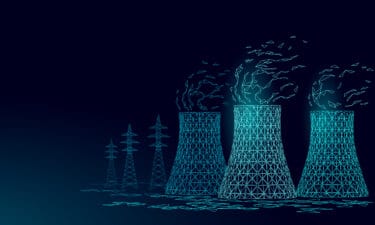Canada has a wealth of oil locked within the oil sands of Alberta. Oil, however, when it is combusted, produces harmful greenhouse gases and the oil sands are a particularly dirty form of oil. In addition, extracting oil from the oil sands is more environmentally challenging, which causes concern. It has many wondering if these environmental risks outweigh the benefits.
Investors must understand the environmental risks relating to the development of the oil sands. It’s crucial to understand what could go wrong and what oil companies are doing to mitigate those risks. If companies don’t take these risks seriously, it could permanently impact the development of the oil sands as well as profits for those companies devoted to developing the sands. Specifically, there are three key environmental risks to watch: Air, water and land.
Air
In 2011 Canada was responsible for 2% of the world’s greenhouse gas emissions, with oil sands production responsible for about 7.8% of the country’s overall emissions. Overall the oil sands are about 9% more carbon dioxide intensive than the average barrel of oil refined in the U.S. There is no doubt that the oil sands are dirtier. That being said, the industry is getting better at reducing the greenhouse gas emissions associated with every barrel of oil produced, with emissions dropping by 26% from 1990 to 2011.
Not only that but the industry is taking steps to reduce its carbon footprint. For example, Royal Dutch Shell (NYSE: RDS-B) has proposed the Quest Carbon Capture and Storage project. This fully integrated project would capture, transport and store one million tonnes of carbon dioxide per year. That’s the equivalent of taking 175,000 cars off the road. It’s projects like this one from Royal Dutch Shell that will improve the environmental impact of Canada’s oil sands.
Water
Another environmental issue that oil sands producers are trying to overcome is water usage. In 2011 the average oil sands mining project used 2.7 barrels of water for every barrel of oil it produced. Meanwhile, the average in situ project used 0.4 barrels of water for every barrel of oil it produced. To combat this problem producers like Devon Energy (NYSE: DVN) and Cenovus Energy (TSX: CVE) (NYSE: CVE) are recycling more water while at the same time reducing the overall water used to produce the oil.
Devon Energy, for example, was the first company to use only non-potable saline water for its oil sands production. Not only that, but the water is recycled up to nine times before it’s injected deep into the ground to be stored. Projects like this that enable oil sands producers like Devon Energy to recycle 95% of the water used in oil sands operations.
Cenovus Energy, on the other hand, focuses on keeping its steam-to-oil ratio, or SOR among the lowest in the industry. The SOR is the amount of steam needed to produce a barrel of oil. Less steam means less water. Like Devon, Cenovus
primarily uses brackish water that isn’t suitable for human or animal consumption. Further, by keeping its SOR down it can keep a lower environmental footprint and can build smaller plants that consume less energy. Best of all, this actually improves the returns it earns for investors and shows that green can also be profitable.
A final example is Imperial Oil (TSX: IMO) (NYSE: IMO). The company’s Cold Lake in situ operation has reduced its water usage per barrel of oil produced from 3.5 barrels in 1985 to just 0.5 barrels today. Not only that but Imperial Oil also recycles 95% of the water it uses.
Land
A final area of concern is the impact that mining the oil sands has on the land. It is estimated that 20% of Canada’s oil sands are close enough to the ground that it can be mined in an open pit. Open pit mining operations have a massively disruptive environmental footprint. That being said, only 3% of the land containing the oil sands will be impacted and the industry can extract about 90% of the original oil in place, which is three times what conventional oil drilling can recover.
Mining operations create large tailings ponds that contain the leftover sand, water, clay and residual oil. One major issue is that this mixture isn’t fit for consumption, so the industry must keep birds from these tailing ponds. Companies like Suncor (TSX: SU) (NYSE: SU) have gone to great lengths to deter birds from landing on the ponds including radar detection which includes sounding cannons to scare the birds away.
Once an open pit mine has given up all of its oil it must be reclaimed back to its original state or better. This includes tailings ponds, and here again Suncor has become a leader in reclaiming the land it has mined. For example, Wapisiw Lookout was one of its first tailings pond in the 1960s. However, it is being reclaimed to include both wetland and dry landscapes. Overall, just 0.02% of Canada’s boreal forest has been disturbed by oil sands operations over the past forty years with 10% of that already being reclaimed and returned to public use.
Final thoughts
Canada might be sitting on a world class oil resource, but it cannot look past the environmental issues surrounding the development of that resource. Thankfully, it isn’t. In fact, the government in conjunction with producers really are going the extra mile to ensure the impact on the environment from developing the oil sands are mitigated.
Still not sure what the oil sands are? Check out part one of our series here. Curious how oil comes from sand? That’s in part two which is available here. Want to know which companies are key to its development? Check those out here. Still have unanswered questions on the oil sands? Stay tuned for our final installment of this series.
Looking for more expert analysis?
Canada is home to another disruptive force in the energy space. Uranium – the key ingredient in nuclear power – could become the energy source of the coming century. Click here now to learn more about uranium’s prospects, as well as two ways to play this potential revolution.
The Motley Fool’s purpose is to help the world invest, better. Click here now for your free subscription to Take Stock, The Motley Fool Canada’s free investing newsletter. Packed with stock ideas and investing advice, it is essential reading for anyone looking to build and grow their wealth in the years ahead.
Fool contributor Matt Dilallo does not currently own shares in any of the companies mentioned. The Motley Fool does not own any of the companies mentioned.







